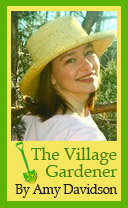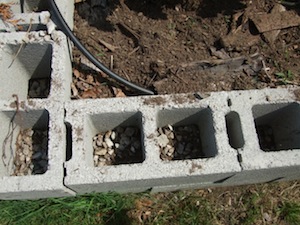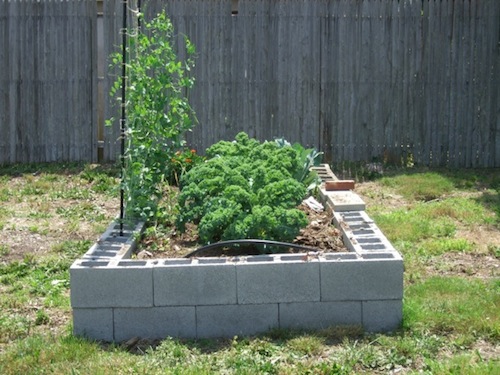If you are thinking of installing raised beds in the garden but you’re not sure how to build the beds from lumber I have found an alternative.
 I have a great husband who was kind enough to build me seven raised garden beds out of lumber. It was a process that involved table saws & drills.
I have a great husband who was kind enough to build me seven raised garden beds out of lumber. It was a process that involved table saws & drills.
If I had to build them myself I probably would have eschewed the power tools and just shoveled dirt into a 4’X8’ pile.
But, my neighbor, Keenan Stephenson, frugal gardener extraordinaire, came up with a great alternative to lumber – cinder blocks. While they can be heavy, they are portable making it easy for Keenan to expand the garden as needed.
Keenan said that the cost to build a 4X8 foot bed is roughly the same for cinder block or lumber – about $25 but the cinder blocks do not have to be cut like wood and they’ll last a lot longer.
 If you lay the cinder blocks with the open sides up you can fill them with dirt to keep them in place and then plant them with border plants. Beautiful and practical! But leave a couple of spots open and you have a nice, wide, 8” edge to sit on while planting or weeding the garden.
If you lay the cinder blocks with the open sides up you can fill them with dirt to keep them in place and then plant them with border plants. Beautiful and practical! But leave a couple of spots open and you have a nice, wide, 8” edge to sit on while planting or weeding the garden.
Keenan filled the double high beds with wood from a tree they cut down last year. On top of the wood he put soil and compost he makes himself. The wood absorbs a lot of rain water and releases it back to the soil over time thereby reducing the amount of irrigation needed.
Vertical gardening is made easy when you can just insert poles into the holes in the cinder block and back fill with gravel or dirt. Then tie string across the poles for the plants to grow up.
Keenan starts many of his plants from seed and they are doing beautifully in his cinder block raised beds enriched with homemade compost.

In the Garden this week:
• Start Indoors: Broccoli, Cabbage, Cauliflower, Brussels Sprouts
• Direct Sow: Carrots, Kohlrabi, Beans, Radish, Beet, Melon, Swiss Chard, Cucumber, Endive, Gourds, Leeks, Okra, Parsnip, Pumpkin, Scallion, Zucchini, Winter Squash, Basil, Cilantro
• Harvest: Beets, Peas, Summer Squash (before they turn into baseball bats), Carrots, Pole Beans, Herbs
• Make Compost
• Top dress garden beds with compost
• The soil is warm enough to mulch garden beds. Mulch with straw for weed suppression and water conservation. Mulch helps keep the roots cool. The straw will settle down and have an attractive silver patina. Use wood chips in perennial beds.
Events in our area:
June 29, 10:30am: Home Canning – Hallockville Museum Farm. The final class in Hallockville’s Food Preservation Series, Mark Vosburgh (New York State Cornell Cooperative Extension Certified Master Food Preserver) will present an informative program on canning fruits and vegetables. Both water bath and pressure canning methods will be explored, including a taste test of Long Island carrots that were canned using the pressure canning method. Bring your questions and kitchen war stories! Advance registration required. $5 Hallockville members; $8 non-members. Become a member now to save on this and other programs throughout the entire year. Visit the museum farm’s website for more information on upcoming events.
![]()
Amy Davidson is a resident of downtown Riverhead and co-founder of River and Roots Community Garden. She has been a backyard gardener for 16 years. When she is not in the garden she is herding seven chickens, two dogs, two cats, two kids and one very patient husband. amy@riverheadlocal.com
The survival of local journalism depends on your support.
We are a small family-owned operation. You rely on us to stay informed, and we depend on you to make our work possible. Just a few dollars can help us continue to bring this important service to our community.
Support RiverheadLOCAL today.































